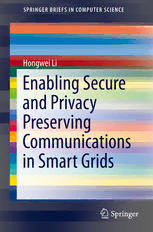Table Of ContentSPRINGER BRIEFS IN COMPUTER SCIENCE
Hongwei Li
Enabling Secure
and Privacy
Preserving
Communications
in Smart Grids
123
SpringerBriefs in Computer Science
SeriesEditors
StanZdonik
PengNing
ShashiShekhar
JonathanKatz
XindongWu
LakhmiC.Jain
DavidPadua
Xuemin(Sherman)Shen
BorkoFurht
V.S.Subrahmanian
MartialHebert
KatsushiIkeuchi
BrunoSiciliano
Forfurthervolumes:
http://www.springer.com/series/10028
Hongwei Li
Enabling Secure and Privacy
Preserving Communications
in Smart Grids
123
HongweiLi
UniversityofElectronicScience
andTechnologyofChina
Chengdu,Sichuan
People’sRepublicofChina
ISSN2191-5768 ISSN2191-5776(electronic)
ISBN978-3-319-04944-1 ISBN978-3-319-04945-8(eBook)
DOI10.1007/978-3-319-04945-8
SpringerChamHeidelbergNewYorkDordrechtLondon
LibraryofCongressControlNumber:2014933524
©TheAuthor(s) 2014
Thisworkissubjecttocopyright.AllrightsarereservedbythePublisher,whetherthewholeorpartof
thematerialisconcerned,specificallytherightsoftranslation,reprinting,reuseofillustrations,recitation,
broadcasting,reproductiononmicrofilmsorinanyotherphysicalway,andtransmissionorinformation
storageandretrieval,electronicadaptation,computersoftware,orbysimilarordissimilarmethodology
nowknownorhereafterdeveloped.Exemptedfromthislegalreservationarebriefexcerptsinconnection
with reviews or scholarly analysis or material supplied specifically for the purpose of being entered
and executed on a computer system, for exclusive use by the purchaser of the work. Duplication of
this publication or parts thereof is permitted only under the provisions of the Copyright Law of the
Publisher’slocation,initscurrentversion,andpermissionforusemustalwaysbeobtainedfromSpringer.
PermissionsforusemaybeobtainedthroughRightsLinkattheCopyrightClearanceCenter.Violations
areliabletoprosecutionundertherespectiveCopyrightLaw.
Theuseofgeneraldescriptivenames,registerednames,trademarks,servicemarks,etc.inthispublication
doesnotimply,evenintheabsenceofaspecificstatement,thatsuchnamesareexemptfromtherelevant
protectivelawsandregulationsandthereforefreeforgeneraluse.
While the advice and information in this book are believed to be true and accurate at the date of
publication,neithertheauthorsnortheeditorsnorthepublishercanacceptanylegalresponsibilityfor
anyerrorsoromissionsthatmaybemade.Thepublishermakesnowarranty,expressorimplied,with
respecttothematerialcontainedherein.
Printedonacid-freepaper
SpringerispartofSpringerScience+BusinessMedia(www.springer.com)
Preface
Asmartgridhasemergedasapromisingsolutiontothenextgenerationpowergrid
system. It utilizes information and communications technology to gather and act
on information, such as the behavior of suppliers and consumers, in an automated
fashion to improve the reliability, efficiency, economics, and sustainability of the
generationanddistributionofelectricity.However,securityandprivacyissuesstill
presentpracticalconcernstothedeploymentofsmartgrids.Inthisbook,weinves-
tigatethreeschemesforsecureandprivacy-preservingsmartgridcommunications.
InChap.2,wepresentanefficientprivacy-preservingdemandresponsescheme
which employs a homomorphic encryption to achieve privacy-preserving demand
aggregationandefficientresponse.Inaddition,anadaptivekeyevolutiontechnique
is further investigated to ensure the users’ session keys to be forward secure.
In Chap.3, we introduce an efficient authentication scheme which utilizes the
Merkle hash tree technique to secure smart grid communication. Specifically, the
proposed authentication scheme considers the smart meters with computation-
constrained resources and puts the minimum computation overhead on them. In
Chap.4,anefficientfine-grainedkeywordscomparisonschemeisproposed.Based
onthehomomorphicPailiercryptosystem,weusetwosuper-increasingsequences
to aggregate multidimensional keywords. As a result, the comparison between the
keywords of all sellers and those of one buyer can be achieved with only one
calculation.
This book presents an overview of the state-of-the-art solutions to secure and
privacy-preserving communications in smart grids. It not only reveals unique
security and privacy characteristics but also offers effective solutions. Security
analysis and performance evaluation demonstrate effectiveness and efficiency of
three schemes. Last but not least, this book highlights promising future research
directionstoguideinterestedreaders.
Sichuan,China HongweiLi
v
Acknowledgments
ThisbookissupportedbytheNationalNaturalScienceFoundationofChinaunder
Grants61350110238,61103207,U1233108,61272525,61073106,and61003232;
the Fundamental Research Funds for Chinese Central Universities under Grant
ZYGX2011J059;andthe2011Korea-ChinaYoungScientistExchangeProgram.
vii
Contents
1 IntroductiontoSmartGrids................................................. 1
1.1 SmartGrids............................................................... 1
1.1.1 CommunicationNetworkArchitecture......................... 1
1.1.2 CharacteristicsofSmartGrids .................................. 2
1.2 ResearchTopicsinSmartGrids......................................... 4
1.3 SecurityPrimitives....................................................... 6
1.3.1 HomomorphicEncryption....................................... 6
1.3.2 BilinearPairing .................................................. 7
1.3.3 Identity-BasedSignature ........................................ 7
1.3.4 MerkleHashTree................................................ 7
1.4 Summary ................................................................. 8
References...................................................................... 9
2 Privacy-PreservingDemandResponseinSmartGrids................... 11
2.1 Introduction .............................................................. 11
2.2 ModelsandDesignGoal................................................. 12
2.2.1 NetworkModel .................................................. 12
2.2.2 SecurityModel................................................... 13
2.2.3 DesignGoal...................................................... 14
2.3 Methodologies........................................................... 14
2.3.1 SystemInitialization............................................. 14
2.3.2 DemandAggregation............................................ 15
2.3.3 DemandProcessingandResponse.............................. 17
2.3.4 KeyEvolution.................................................... 18
2.4 SecurityAnalysis......................................................... 20
2.4.1 Authenticity,DataIntegrityandConfidentiality ............... 20
2.4.2 PrivacyPreservationofElectricityDemand.................... 21
2.4.3 ForwardSecrecyofUsers’SessionKeys....................... 22
2.4.4 EvolutionofUsers’PrivateKeys ............................... 24
ix

